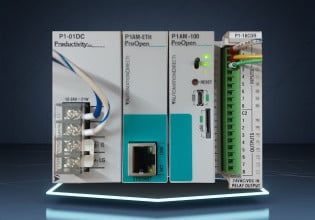S
Hello all,
I have the following challenge (I apologise for the amount of text, but this had to be done without accompanying figures/schemes/pictures).
I am looking for a control configuration for the following system: A static mixer which has two inflows A and B and one outflow C.
The set-up is as follows:
Flow measurement and Temperature measurement in outflow C.
One control valve in inflow A (valve A).
One control valve in inflow B (valve B).
Flow A is main process water system of the plant with temperature depending on weather conditions between 15°C in winter and 30°C in summer. Flow B is hot water with a stable temperature of 55°C. Outflow C has the following requirements/setpoints as a consequence of different demands (sequence operated):
1) 30°C and flow about 9000 kg/hr
2) 40°C and flow about 40000 kg/hr
3) 55°C and flow about 30000 kg/hr
Of course, temperature and flow are coupled in this system. I would like to implement this in the DCS so that the system is decoupled.
I cannot figure out how this should be done.
I am familiar with the following steady state equations:
flow C = flow A + flow B
temp C = (flow A * temp A + flow B * temp B) / flow C
I also know the classic example of the heat exchanger and bypass, flow and temperature measurement/control; one control valve in stream through heat exchanger and one control valve in bypass.
if the output of the flow controller is "a" and the output of the temperature controller (note control action: reverse) is "b" then, this system is decoupled when the outputs to:
-the bypass valve = b-a
-the heat exchanger valve = b+a
another (classic) solution is:
-the bypass valve = b*(1-a)
-the heat exchanger valve = a*b
I would like to have something like this in my static mixer problem.
The objective is that if flow setpoint is increased, both control valves A and B are opened further proportionally as to not change the temperature of the mixture. This means that output of the flow controller "a" should be a factor to both valves. When setpoint 55°C is required, valve A completely closed. I don't know how to implement the "b" in the outputs to the control valves to have the best stable control.
I would appreciate hints and tips
thanks in advance
Sven
I have the following challenge (I apologise for the amount of text, but this had to be done without accompanying figures/schemes/pictures).
I am looking for a control configuration for the following system: A static mixer which has two inflows A and B and one outflow C.
The set-up is as follows:
Flow measurement and Temperature measurement in outflow C.
One control valve in inflow A (valve A).
One control valve in inflow B (valve B).
Flow A is main process water system of the plant with temperature depending on weather conditions between 15°C in winter and 30°C in summer. Flow B is hot water with a stable temperature of 55°C. Outflow C has the following requirements/setpoints as a consequence of different demands (sequence operated):
1) 30°C and flow about 9000 kg/hr
2) 40°C and flow about 40000 kg/hr
3) 55°C and flow about 30000 kg/hr
Of course, temperature and flow are coupled in this system. I would like to implement this in the DCS so that the system is decoupled.
I cannot figure out how this should be done.
I am familiar with the following steady state equations:
flow C = flow A + flow B
temp C = (flow A * temp A + flow B * temp B) / flow C
I also know the classic example of the heat exchanger and bypass, flow and temperature measurement/control; one control valve in stream through heat exchanger and one control valve in bypass.
if the output of the flow controller is "a" and the output of the temperature controller (note control action: reverse) is "b" then, this system is decoupled when the outputs to:
-the bypass valve = b-a
-the heat exchanger valve = b+a
another (classic) solution is:
-the bypass valve = b*(1-a)
-the heat exchanger valve = a*b
I would like to have something like this in my static mixer problem.
The objective is that if flow setpoint is increased, both control valves A and B are opened further proportionally as to not change the temperature of the mixture. This means that output of the flow controller "a" should be a factor to both valves. When setpoint 55°C is required, valve A completely closed. I don't know how to implement the "b" in the outputs to the control valves to have the best stable control.
I would appreciate hints and tips
thanks in advance
Sven






